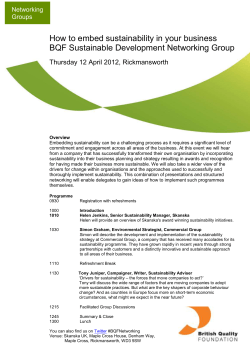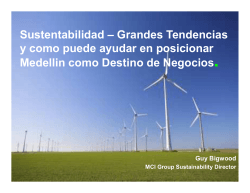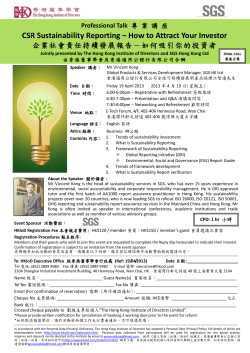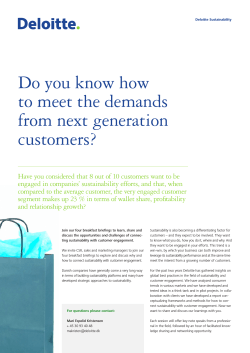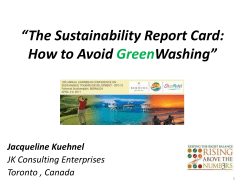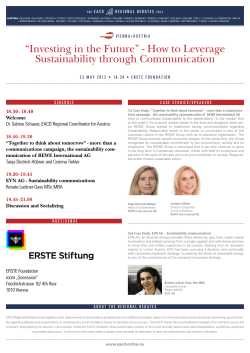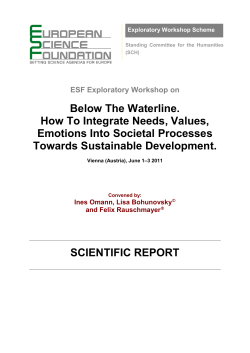
HOW TO USE THIS MAP
form a grid for exploring future sustainability strategies. IG LS NA signal banners. They form a landscape SU of innovations that are likely to appear www.witness.org over the coming decade. are high-impact, hard-to-predict events that can significantly alter the sustainability strategy landscape, bringing potential disruption and unique risks. Finally each row has one engine. The Engine engine includes the fundamental principles, philosophies, and approaches that drive the overall strategy and the types of innovations it includes. the most important insights come from connecting several innovations across the map. Draw a line through signals that seem most important and tell that story to your colleagues. G R Mature eco-health literacy drives new “green filters” on health practices and purchases G D AT O R Y H E A LT H S C R E E N I N the greatest challenges to your organization? • Explore the challenges and innovations to guide Action. The does: the services it provides, the products it delivers, or the causes it promotes. How might you redesign these to take advantage of sustainability innovations—and meet these critical challenges in the next decade? Most of society’s resources are mobilized to support scientific and technological solutions to sustainability dilemmas—creating new economic engines and stimulating a global drive to innovate ahead of ecological and social crises. The redirection of resources, though, may exacerbate social injustices. HIGH- SR-1119A | © 2008 Institute for the Future for BSR. All rights reserved. All brands and trademarks remain the property of their respective owners. Reproduction is prohibited without written permission. FINA P U TAT I O N S S TA I N A B I L I T Y R E Regenerative commerce protects local economies Micro-venture capitalists create new global funding network P2P banking fosters community and commercial growth E XT 150 100 4.4 Source: IFTF 8.7 12.9 17.1 21.4 M A Simulation models of children’s health and life trajectories guide early care, policy, and—in aggregate—social planning 200 0 RK REA T ACCOUNTI PA C N I MFuture impacts on the G W and corporate trading in: Carbon sequestration Crop pollination Flood control Distribution of people who profess extended-self attitudes ER GE NA Global migration strategies and policies in response to climate refugee politics, population imbalances, and shifting labor needs Tools to help individuals gauge—and manage—their ecological and economic impacts, using lifecycle models ISTR RED U SVVs Online tools support global learning curricula— with everything from visual books to virtual worlds to simulation and gaming LOC ND ES Policy mechanisms protect local value Commerce and labor Health and culture Natural resources and ecosystems Embedded environmental sensors, networked research stations, and science satellites enable continuous environmental monitoring—and automatic intervention C U L A R M A N U FA C T U R I N G Working with materials at the molecular scale reduces waste, supports small-scale manufacturing—and poses unknown threats SUS TA I N A B L E “ L E V I T RE ” TOWN Experiments with green building and planned communities drives rapid innovation in construction, housing, and community services Las Gaviotas Masdar City Destiny, Florida N E WA B L E P O R T F O L I O Smart walls and RFID Embedded sensors Map mashups and tagging Personal impact reporting Regional energy dashboards Real-time feedback displays STE = RE O B BUS IG WEB D O N C Nano-scale purification can remove toxins and viruses in situ at extremely low costs T UL www.seldontechnologies.com EN 65 2010 T ” C E N AT I O N A L I S M N OE E R G Y- P R O D U C I N G H O M E S Nano-solar material and paper batteries begin to transform the construction industry SE Governments at all levels establish emission quotas which form the basis for emission trading and set a framework for punitive action SU BANK ED GINE I M U L AT I O N O-S C E Sophisticated simulation tools Facing the possibility of a 70% decline in the number of species, cryogenic technologies are used to create vast repositories of plant and animal specimens PLA N E TA R Y M P LANGUAGE ARK-U Integrated standards for field data across disciplines H BAL K POLICY FR AMEWOR International Resource Management Board adopts a set of integrated standards for global climate management, natural-resource distribution, biodiversity, and labor and human rights I NV ERING S AND FROZEN ZOOS UT S TA I N A B L E S O O GL Biosphere management Guided R&D Planned demographics Bioregional design Megapolitan planning and ocean chemistry, aimed at preventing global climate disaster S TA N D A R D S C O N S O R T I U M International consortium of businesses establish and enforce metrics and standards across key environmental and social issues South-to-South trading and political coordination sets a separate agenda for global sustainability strategies Design is Policy Localism vs. globalization debates? BAL Mercenary forces are engaged in eco-protection, personal security? E Massive projects alter atmospheric D M E AT URE The pencil-sized Seldon Waterstick can purify a liter of liquid in 90 seconds Domestic tradeable quotas—or personal quotas—drive emissions down MISSIONS QUOT AS ABLE E S ED ECOSYSTEM S TA I N A B I L I T Y U C AT I O N F O R S U As arable lands are disrupted, research on lab-grown meat increases 2050 Year Source: Richard Starksky Results-oriented ecological and social-impact curricula are standard in public education SOUR ERSITY TRIALS Taking a page from the tobacco trials, states hold companies in key industries responsible first for carbon emissions and then for loss of biodiversity Eco-science helps shift legal protections from individual endangered species to ecologies of interdependent plants and animals Following the lead of Venezuela, Bolivia, and the Sakhalin Peninsula in Siberia, more countries and regions nationalize their resources I F I C AT I O N PUR Regional resistance to technology—new Luddite movements—disrupt economies and redraw political boundaries? EN ED RE BON & BIODIV O GL ALL GARDENING NOW PROTECTIONS E SOURC A wiki-database connecting people, social causes, and NGO’s CAR 150 DE RA Bottom-up green governance turns into green fascism? commons foster rapid implementation of sustainability and social justice strategies Mtc As Daniel Janzen argues, there is no footprint-free world, and all nature needs to be carefully managed and maintained Governments intervene to protect the food web from Regional food deserts Overforaging Species extinction Food chain disruptions Enabled by wireless technology and quantum encryption, plebiscites transform “command and control” to “poll and control” policy E W Social networks and solutions- Carbon Budget, Annual Emissions From Energy Use Critical resources (oil, water, fisheries) collapse due to overuse? GER DAN monopolies in policy setting, resource distribution, and even enforcement S DEMOCRACY IL SOCIETY GY New business models focused solely on global innovation for sustainability channel vast amounts of R&D funding “IT’S S TA N D A R D SM INESS, BIG E SCIENC AN (RE)MINING Cradle-to-cradle design + molecular technologies turn waste into leading source of raw materials O AN CIV NANCE BY NGO G O NGO networks challenge government inspires participatory enforcement of Zero-footprint goods Renewable energy Biodiversity and ecosystem protection TRUSTS ETIC BIOL O R VE I O “Declaration of Biosphere Rights” Bioengineering matures, with new markets for biomaterials and IP Biomimetic designs Engineered ecosystems Bio-hacked bacteria Governments support a flexible, market-driven policy to ensure that a minimum amount of renewable energy is included in the portfolio of utilities Attacks on key energy, communication networks disrupt society and markets? Making the Invisible Visible NTH Metal and mineral collection from existing buildings, landfills, junkyards WA -SENSOR NETWORKS EC O Semi-autonomous, mobile systems offer low-impact alternatives for military operations, agriculture, transportation, and myriad institutional tasks Nanofabricators can assemble physical goods molecule by molecule Car-sharing system enables on-demand mobility URB New kinds of infrastructures become public utilities Transportation services (paid monthly) WiFi communication Nations experiment with incentives for “undeveloping” specific regions to support both quality of life and biodiversity I M PA C T R O B O T I C S L O W- MOLE A L VA L U E P O LICI SY lichen, algae, switch grass, even new species— help address food and fuel challenges ER NSURANCE POW ERE RIGHTS Institutions created to protect biological life from privatization, IP patenting, and biopiracy G ( A Agricultural and biological innovations— PUBLIC UTILITIES NE W New sustainable infrastructures are funded through taxes on sustainability footprints—and measured infrastructure use BIO TURED ORGANISMS )CUL Pressure from the reinsurance industry accelerates adoption of sustainable strategies and resiliency R U C T U R E TA X E S NT POLICIES LOPME Silicon Valley-style innovation brings radical new technologies, infrastructure designs and service models to the world of mobility The multiplayer game Operation Climate Control challenges students to set 21st Century environmental policy People experiment with diet, pharmaceuticals, implants, genomics, and lifestyle to extend their www.operationclimatecontrol.co.uk senses, physical and cognitive abilities, social LY R E S P O N S I B L E G E O M A P P I N G L A I C reach, and ultimately their lifespans SO Scientists and citizens geo-tag zones of hazard and human rights abuses Toxicity and health risks Crime and physical danger Gender and racial discrimination NF ST RA H SP Food issues—food v. fuel, food deserts, food IP—are ground zero for conflict? Small-scale power solutions—such as small wind-based generators and bio-fuel cells—produce a growing share of global energy physical goods to services, opportunities emerge to decrease material production The rules for social & polical behavior In the face of collapsing food webs, ad hoc collective disaster response reorganizes food distribution ROPOWER MAR KETS RI The biologically integrated worlds we live in T FA M I N E R E S P O N S E distribution, and accountability Urban microfarms Super (farmer’s) markets IZING WNS Individual and corporate income tax is replaced by carbon tax—you burn it, you buy it EVE Soil fertility Water provision Biodiversity S I B U T I V E C A R B O N TA X National and international bodies take strong action to regulate philanthropy to meet policy objectives MIC EN ERG OOD PF P 2Decentralized food production, Distributed guerilla networks dismantle national grid and redistribute energy production to trade sustainability-focused companies and instruments REI EM ENERGY D ODriven by a shift in spending from Voluntary eco-labeling practices evolve into mandatory eco-, human-rights, and socialimpact labeling standards L AT E D P H I L A N T H O P Y R LEARNING ECOLOGIES SONAL LIFECYCLE TOOLS H U M A N C A PA C I T Y ENDED GU RE New corporate actors create new kinds of markets Social entrepreneurs Hybrid models B-corporation TA I N A B I L I T Y L A B E L I N G US Fewer than half of Katrina refugees have returned to New Orleans D M I G R AT I O N C O R P O R AT E S T R U C T U RE P2P L A L Entire stock exchanges emerge M S E RV I C E S M A R K E T S YSTE OS C E Global and local value assigned for personal, regional, RECYCLING Online match-ups focus on reducing waste E E T A S WAT C H D O G STR Tools for transparency enable immediate risk-mitigation and strategy adjustment environment, communities, and human health are modeled and included in business accounting NEW L-TIME FEEDBAC K P2P Public wikis and online reputation systems link to real-time practices, places, products, and services P2P axis Ad hoc mesh wireless networks P2P VOIP Reverse electrical meters Small-scale power storage Home wastewater treatment Small-scale desalinization L E-UNIONS networks negotiate transnational labor agreements Kiva matches people online for microloans Ethics, individual consciences, and global values discourse offer a strong organizing force Cap-n-trade markets Millenium Development Goals Human and social capital Health credits Biodiversity markets Personal footprinting Sustainability dashboards Digitization of media and rise of virtual lifestyles become a strategy for lowering environmental footprints and reducing physical consumption G U A G E P R E S E R VAT I O N S Handheld devices provide personal access to medical records, diagnostics, diet recommendations, and suggestions for traditional as well as Western medical remedies Frequency MA SOURCE DESIGN Lightweight Infrastructures G Distributed online social Y AND MEANING Consumer social responsibility + collective buying cooperatives drive the sustainability market I N T H E M E TAV E R S E ETS NPE NCIAL COMMONS BA LO ALIT O Public wikis and online reputation systems link to real-time practices, places, products, and services Values and Valuation Distribution of sustainable citizens As localism grows, language preservation movements proliferate— and trigger global debate TECH PERSONAL MEDICIN 50 124 University Avenue, 2nd Floor Palo Alto, CA 94301 650.854.6322 www.iftf.org LAN E biodiversity, and food. Think about what your organization Open tools and platforms disrupt traditional industries with P2P production and distribution— and commons-based property regimes MOBS Urbanization as ecoimperative or path to “planet of slums”? shared societal resources, though Society gives up privacy not all discourses agree in the name of health, Guaranteed living income security, and environment? Public health Information access ABLE CHILDREN Political voice TA I N SU SCIENCE & TECHNOLOGY 40.0 iTunes is the #1 music retailer in U.S. BAL PUBLIC GOODS L OInternational institutions support Which strategies are easiest for you to adopt? Which provide health, climate, human rights, water, economic well-being, 30.0 Source: Institute for the Future, American Lifestyles Survey, 2006. POLICY back of the map highlights key sustainability challenges: 20.0 Sustainable Citizen Index score Source: Institute for the Future, American Lifestyles Survey, 2006. “Big brother is taking your pulse”— for all travel, employment, citizenship In the face of rapid deterioration of the environment and the global human condition—as well as recognizing the slowness of the markets to drive fundamental behavioral changes—governments intervene with regulation and funding of programs aimed at control and remediation. C S M A RT SR 25 H E A LT H EEN G • Trace a path through the map to provoke Insight. Sometimes 50 10.0 a strategic scenario. Work across the row to explore the How are they likely to change the way you do business? Fragmentation of metrics, options, and marketplace rewards creates sustainability fatigue? 75 SU ECONOMY 0 MAN • Focus on the strategies to build Foresight. Each row represents innovations that are most important for your organization. 125 Humans become commodities? Tradeable body parts? Tradeable IDs? Market-led sustainability leverages market strategies to manage the ecosystems and improve social conditions at all levels—from households to farms, factories, cities, and the planet. Market incentives drive consumer and corporate behavior alike, aligning work and play, public and private life with changing environmental realities and human needs. Working with the Map: signals of innovations in this scenario. Then look for the 150 100 MARKETS A national network of rural sustainable companies and cooperatives Personal self-interest will focus sustainability efforts on local communities Number of people Distributed monitoring and protection of human rights reduces abuses worldwide H Dotting the map are wild cards. These Distribution of Sustainable Citizens AN RIGHTS COMMONS UM S TA I N A B L E C I T IZENS OR M S Waving across the map are dozens of Lightweight sensor networks + mobile Niche groups + social networking tools = sensing devices = bottom-up environmental powerful new civic actors monitoring B L I C ’ S H E A LT H Biocitizens Footprinting, of self and neighbors E PU H New diasporas T Measuring impacts of human activity People use new technologies and Transgeographic citizens Input to ecosystem modeling commons models to collectively Big-box retail watchers manage public health E MARGIN O VAT I O N F R O M T H N Volunteer professional health providers N I • Urban squatters and slum dwellers User-generated health databases • People with disabilities Distribution of Sustainable Citizens Decentralized health solutions • Displaced persons Bottom-up investment plans Self-organizing communities of interest around shared vulnerable resources address issues of sustainability through participatory solutions. These new commons are at the heart of a bottom-up reorganization of society, disrupting traditional markets and government programs and providing human-centered innovations that contribute to sustainability—and a new civic society. OPEN Personal tools to monitor pollution levels and communicate with cell phones, then databases GOVERNANCE E diverse arenas of innovation. Together the rows and columns T L E S I S T E R I S WAT C H I N G ECOSYSTEMS N representing diverse perspectives, or lenses, on sustainability— COMMONS LIT NATURAL RESOURCES The range of materials we use to sustain human activity B challenges. These four rows intersect with seven columns, LITICAL IDENTITIES W PO NE INFRASTRUCTURE The built environment & mechanisms that keep it going G representing four broad strategic responses to sustainability The ways we live together in communities THE ECONOMY The production, distribution & valuation of goods & services I ity strategy for the coming decade. It’s organized in four rows, CULTURE AND SOCIETY F 2020 HUMAN WELL-BEING The individual experience of health, happiness & identity S The 2008 Sustainability Outlook Map is a guide to sustainabil- SUSTAINABILITY OUTLOOK P HOW TO USE THIS MAP model ecologies, communities, regions, and global dynamics RO N TA MEN L ARMED FORCES Extreme environmental and social crises lead to armed enforcement of sustainability— either military or mercenary Social and economic inequality are driven by unequal access to heroic technology? MO ONLAN OD DING AS M EL Integrated R&D programs, resembling the space-programs of the 60’s, guide innovation and adoption of new technology The Svalbard Global Seedbank protects plant species from “doomsday” scenarios http://regjeringen.no/en/dep/md/campaign. svalbard-global-seed-vault.html © 2008 Institute for the Future for BSR. All rights reserved. All brands and trademarks remain the property of their respective owners. SUSTAINABILITY OUTLOOK 2020 Health CLIMATE HUMAN RIGHTS WATER ECONOMIC WELL-BEING BIODIVERSITY Glossary FOOD A Strategic Map of an Uncertain Horizon The language of the Sustainability Outlook Map may be As we look out toward 2020, we come face-to-face with the challenge of sustainability. We see growing uncertainty about the potential for individual health and happiness around the world. We see disruptions in our social and economic systems. We struggle to understand the impacts of climate change. Facing these challenges, we recognize the need for innovation. We know this innovation must go beyond sustaining our current business models or even surviving as organizations. It must also ensure the well-being of individuals, our collective society, and the ecosystem within which we all seek to thrive. This is the very definition of sustainability. Yet there are so many perspectives on sustainability. We can view it through such diverse lenses as human health and well-being, society and culture, the economy, our infrastructure and natural resources, multiple embedded ecosystems, and of course, governance. Each of these perspectives creates a slightly different definition of sustainability—and poses a somewhat different challenge. The Challenge: The Challenge: The Challenge: The Challenge: The Challenge: The Challenge: The health paradox: as our life-spans increase, we face a A complex set of interacting systems, the climate changes In a world of globalization, cultures converge and con- Water is at once utterly commonplace and extraordinarily Wealth is a basic building block for human well-being. As demand for material inputs continually increases, The path of our food, from the seed to the plate in front growing variety of possible threats to our biology. Some slowly but inexorably. Many of the underlying geophysical flict, resulting in a lack of shared understanding of precious. Because water is an essential need for all forms In a world of haves and have-nots, the existing gap is transformation of natural habitat into cultivated property of us, depends on a delicate system of interrelated factors Biocitizen: Individual taking political and identity interest in of these threats come from modifying our world without processes display profound lag; climate disruptions we human rights. At the same time, technologies of com- of life, demand from individual, collective, and institutional reinforced and at times exacerbated by unequal access to seems inevitable. Careless development and unintended that are not always visible to the consumer. From the health-related issues. thought of consequence. Nearly everything we touch—the see today reflect atmospheric and oceanic changes from munication and information (from camera phones to the use increasingly puts pressure on fragile supplies. Access opportunities and environmental disruption. At the same consequences can lead directly to the elimination of unique role of bees in pollination, to seasonal harvest timings, to air we breathe, the food we eat, the products we handle— two or three decades ago. As we look at changing weather Internet) make it possible to document human rights to clean water is considered a human right by many, setting time, new innovations, both technological and social, offer life forms as well as damage to complex ecologies. Reduced the resilience of crop diversity in the face of unexpected relies upon synthetic chemicals or complex engineering. patterns, temperatures, and water levels—as well as abuses and share the images with the world. Due to ongo- up conflict when supply is not available where and when alternative models for collaboration, organization, and biodiversity means increased environmental brittleness. This blights—the weakening of any of these factors could cause And as we gain a better understanding of human biology resulting changes to soil quality, animal habitats, bird ing dynamics of power and influence in an increasingly demand calls for it. New technologies may provide access foresight. These innovations may offer ways to deal with has direct consequences for human activities, undermining our food system to fail. Climate change, unsustainable Biomimetic: Industrial design following the patterns of nature, and develop better tools for monitoring our environments migration paths, and more—we recognize the imprint of complex system, efforts to protect society may uninten- to previously unavailable sources, even as over-consumption long-standing dilemmas, but can introduce new dilemmas ecological services such as oxygen production and new development, and industrial waste are all disrupting local especially natural processes. and ourselves, we see indicators of a general decline in human activity. We are transforming the climatic context tionally subvert individual and collective freedoms. How and pollution deplete aquifers. How do we ensure that our of their own. Throughout, one question dominates: How can drug discovery. Disrupted and collapsed ecologies are more food webs and threatening global food supply. How can we human health globally. How do we stay healthy when our that has enabled life to flourish into one that is unstable, do we ensure that human rights are understood, respect- supply of water is clean and accessible by all who need it? every individual secure enough wealth to lead a good life? likely to produce invasive pests (and potentially zoönotic protect our complex and fragile system of food production bodies are in continuous experimentation with our rapidly uncertain, and possibly uninhabitable over time. How do we ed, and protected? pandemics), and can damage neighboring ecosystems. How and distribution? transforming surroundings? find solutions for mitigation and adaptation? Innovations on the Horizon: Innovations on the Horizon: Innovations on the Horizon: Innovations on the Horizon: Innovations on the Horizon: Innovations on the Horizon: Innovations on the Horizon: Human Rights Commons enable the collaboration of I ndividuals know how their behaviors impact the global Global e-Unions enable workers to have a stronger BioTrusts institutionalize the rights of biological forms P2P Food localizes certain food systems, making them Health is managed collectively from the bottom up. expertise necessary to tackle our shared climate problem. people all over the world in protecting and promoting water supply and can adapt accordingly when Little Sister collective voice and effectively negotiate and increase and ensure their preservation. more resilient while bolstering community resources. At the same time, we know that there will be profoundly different strategies for sustainability, based on different philosophies that cut across the various perspectives. G reen Health consumers drive demand for products and B usinesses and institutions that impact the planet’s human rights. is Watching. their economic worth. services that have been developed with consideration for climate are kept in check through Carbon Trials. A s company stock value takes into account human A shift in consumer demand from products to services A Carbon Tax turns the economy on its head, cascading rights, there is a new role for Wall Street as Watchdog. leads to Downsizing material production and reduction in How do we make sense out of this diversity of innovation? N ational governments come together to provide health- incentives to reduce emissions throughout the system. I ncreased international coordination on sustainability The 2008 Sustainability Outlook Map answers this question by focusing on four main strategies that capture possible societal responses to the demands for sustainability: care as a Global Public Good, ensuring that we all I ndividuals use Personal Lifecycle Tools to live a more leads to a stronger Global Policy Framework, including climate-conscious existence. Ecosystem Services Markets provide the environment with Organizations measure and mitigate their impact on N ew perspectives are represented in the world economy as a place in the economy in an attempt to keep it from the ecological foundations of food production through Innovation from the Margin leads to business opportunities. being externalized and undervalued. Impact Accounting. T hrough Managed Migration policies, governments W hen push comes to shove, government steps in with Governments and organizations operate sustainably G overnments examine entire Endangered Ecosystems to address issues facing displaced individuals, including Undevelopment Policies to restore biodiversity. within a framework of Food Web Protections. policies to advance human rights. inform policy development for effective water distribution. discrimination and inequity. P eople versed in Planetary Mark-up Language contribute Cultured Meat offers an alternative approach to serving I ndividuals take their health into their own hands Socially Responsible Geomapping enables people to N ext-generation living designs lead to the development of Eco-Simulations enable people to see the potential impacts their share of knowledge about the earth to co-develop meat without the negative impacts on animals, land, empowered by High-tech Personal Medicine through track where human rights abuses are taking place Sustainable “Levittowns” and smarter water systems. of their decisions on the economic well-being of others. ecosystem solutions. water, and air associated with farming cattle. mobile devices. around the world. our physical well-being. receive basic services at a minimum. Markets strategy focused on alternative capitals, A financial incentives, and market dynamics. Science and Technology strategy that propels sustainable A behavior and operations through technological innovation. experimental way. Biopiracy: Developed nation companies patenting and making proprietary various uses of plants found in developing nations. the water used in manufacturing processes. able than previous generation). Food Desert: Urban district with little or no access to foods needed to maintain a healthy diet (but may be served by fast food restaurants). Markup Language: Any artifical language used to define how content is structured and displayed, e.g. HTML (hyper-text markup language) is used to construct web pages. Mashup: Digital media concept mixing two or more disparate sources to create a mixed whole. New Diaspora: Emerging model of diffuse communities, sharing identity but not geography, usually linked by the Internet. P2P: Peer-to-peer, a distribution mechanism without centralized control, user to user. RFID: Radio Frequency Identification, a technology using Example | Voxiva provides mobile applications that Example | The Carbon Tax Center is a U.S.-based Example | Crisis in Darfur is a layer in Google Earth Example | Pavements made from pervious concrete Example | Katrina disaster innovation resulted in easily Example | Colombia is carrying out a debt-for-nature Example | VG2007+ is a two-year pilot project to turn small chips able to carry individual data about a package, allow patients and healthcare providers in rural areas to grassroots organization consolidating momentum for where the U.S. Holocaust Memorial Museum’s Genocide allow for storm water to pass through, replenishing assembled, recyclable, and inexpensive cardboard-based swap in which part of Colombia’s debt to the United yards, window boxes, rooftops, and unused urban plots product, or (potentially) a person. access health care databases: implementing a carbon tax: Prevention Mapping Initiative has provided information groundwater and decreasing runoff: shelter designs: States was canceled in exchange for funding a trust and into a citywide network of urban farmers: http://www.voxiva.com/ http://www.carbontax.org/ to map destruction throughout Darfur: http://smokeypointconcrete.com http://www.dexigner.com/architecture/news-g5344.html supporting organizations to preserve its tropical forests: http://www.futurefarmers.com/victorygardens/ Smartmob: A self-organizing group of people, mediated through http://earth.google.com/outreach/cs_darfur.html Each of these strategies represents a distinctive approach to sustainability, with its own set of innovations for everything from health and education to the economy and the environment. Together they offer us a grid for making sense of the coming decade. In the end, environmental, social, and economic sustainability cannot be separated. A sustainable planet must include a sustainable human civilization—resilient human systems that respect the complicated relationships among poverty, human rights, economic development, environmental health, and human success. This map is designed to be a guide to this endeavor. Bio-hack: Genetic modification, particularly in a quick-and- and “upcycling” (where recycled products are as or more valu- O pen-source Design brings together the diversity of Policy strategy that leverages legislative interventions, A ranging from setting market standards to command-andcontrol administration. want to make sure you recognize: Cradle-to-Cradle: Design process emphasizing material reuse do we ensure the resiliency of our biosphere? E nabled by networks and databases, The Public’s A Commons strategy dominated by bottom-up, participatory solutions. unfamiliar in definition or usage. Here are some terms we The Challenge: http://www.panda.org/news_facts/successes/index. social technologies, capable of complex emergent behavior. Tagging: Assignment of keywords to media, usually by both cfm?uNewsID=13148 creators and users, allowing for flexible filtering. Urban Squatters: Communities emerging in abandoned structures or open areas, ignoring or violating existing property ownership. Wiki: A collaboratively-edited Web site, usually in order to gather best knowledge from participating readers, e.g. Wikipedia. Source: http://www.comminit.com/en/node/134885/307 Open-Source: Production method where the instructions and Source: http://www.carbontax.org/ Source: http://techyum.com/2007/04/googlemapping_atrocities_in_da.html Source: http://www.smokeypointconcrete.com/company/press/stratford_place.php component information (e.g., software source code) is freely Source: http://www.dexigner.com/architecture/news-g5344.html http://www.flickr.com/photos/31536282@N00/2601408480/ Source: http://www.futurefarmers.com/victorygardens/ given away, allowing for individual modification, with the caveat that all future modifications should remain freely available.
© Copyright 2025
